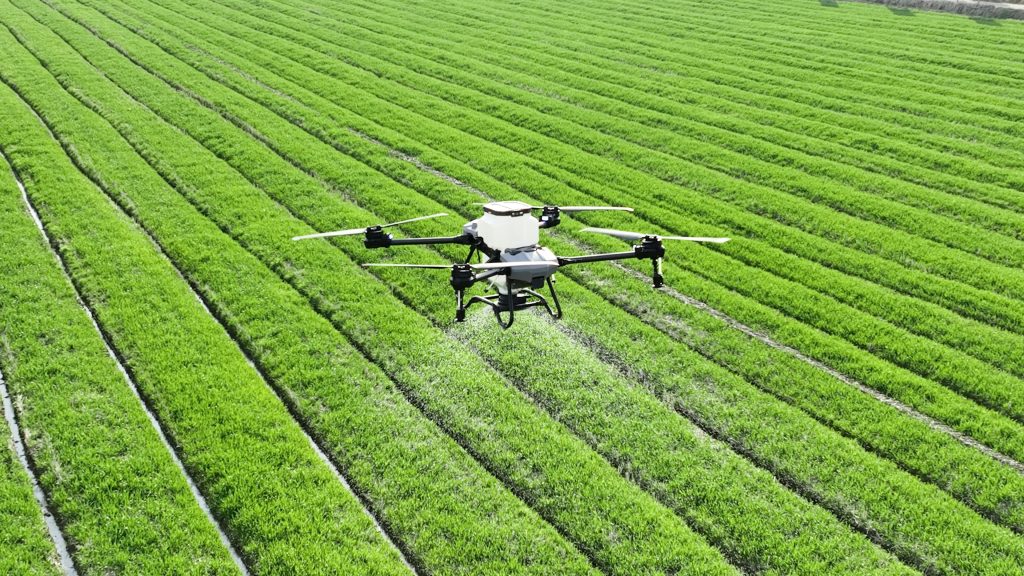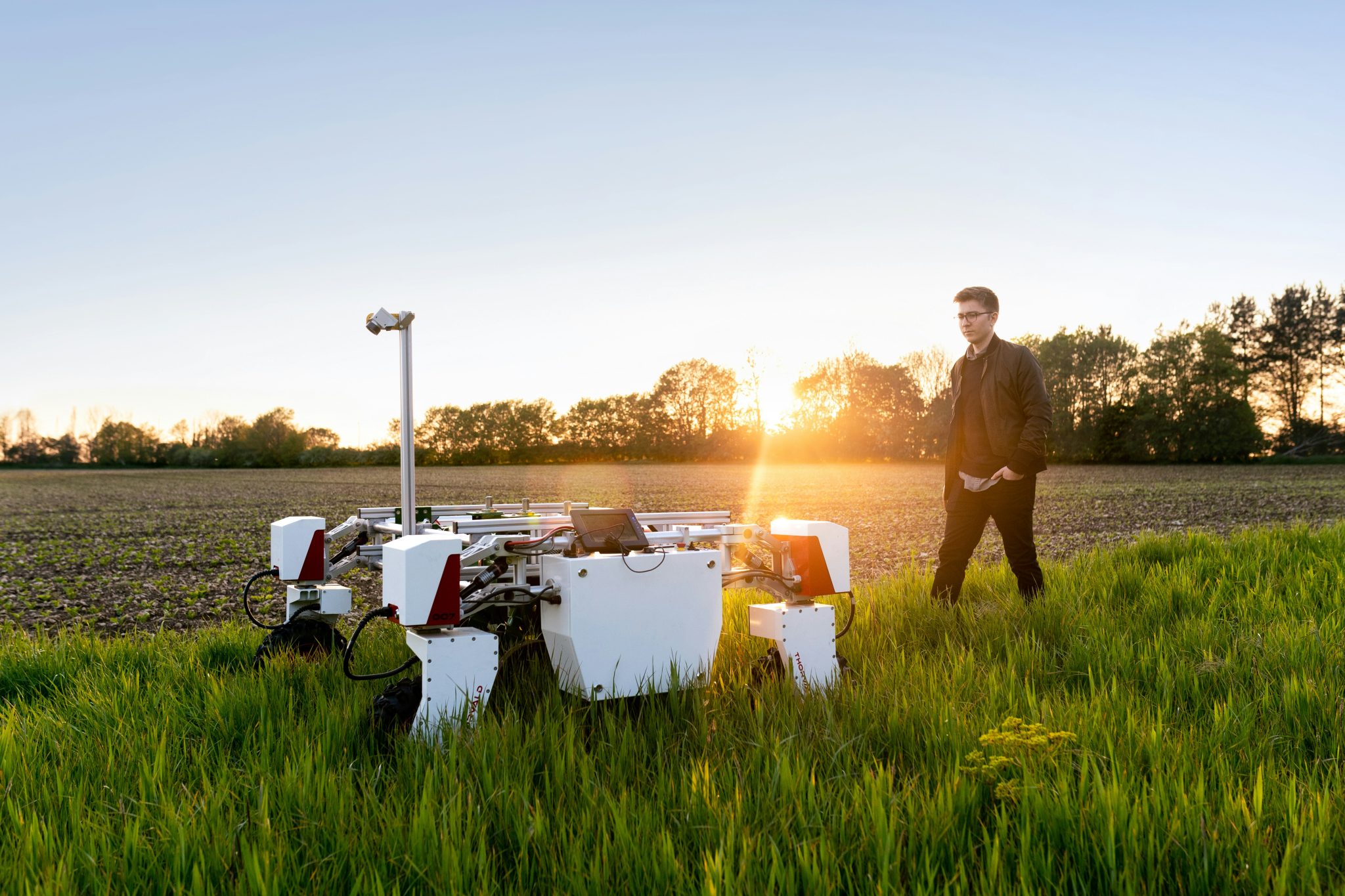Across the farmlands of California, drones glide over vineyards, scanning leaves for early signs of stress. In India, smallholder farmers use their smartphones to photograph rice plants and receive instant diagnoses through AI-powered apps. In Europe, autonomous tractors guided by satellite data plow the soil with remarkable precision. What connects these scenes is a quiet revolution powered by artificial intelligence.
AI has become the new engine of global agriculture, reshaping how food is grown, managed, and traded. With the world’s population expected to reach 10 billion by 2050, traditional farming methods can no longer meet rising demand. The combined pressures of climate change and food insecurity are driving a digital transformation in the fields.
Artificial intelligence, once confined to research labs, now determines when to sow, how much to irrigate, and which crops can best withstand droughts and pests. The results are already visible. In California, AI-based irrigation systems have increased yields by 25 percent while cutting water use by 20 percent. In developing countries, image-recognition apps help farmers detect diseases early, preventing catastrophic losses.
This is more than a story about technology. It is a shift in global power. As AI drives productivity, it is also redrawing the map of agricultural trade, influencing who feeds the world and who struggles to keep up.

How AI Improves Crop Productivity
The promise of artificial intelligence in agriculture lies in its ability to turn data into decisions. Every field, soil type, and weather pattern tells a story, and AI has become the translator. By analyzing information collected from drones, satellites, and Internet of Things (IoT) sensors, algorithms can recommend the best time to plant, the precise amount of fertilizer to apply, and the right moment to harvest. The result is higher yield, lower cost, and more sustainable use of resources.
Precision Farming and Smart Irrigation
AI-driven precision farming is transforming the way farmers use water, fertilizers, and pesticides. Sensors in the soil monitor moisture and nutrient levels, while drones capture aerial images of crop health. The data are processed in real time, allowing systems to make automatic adjustments. In California, for example, AI-managed irrigation increased grape yields by 25 percent and reduced water use by 20 percent. In countries like Israel and the Netherlands, smart irrigation has become the backbone of high-efficiency agriculture, turning limited water supplies into record harvests.
Machine Learning for Forecasting and Early Detection
Machine learning models can now predict weather shifts, soil changes, and even outbreaks of disease before they happen. By studying years of environmental data, these models alert farmers to act early and minimize losses. Image recognition tools are also playing a critical role. In India, the Plantix mobile app uses AI to diagnose crop diseases from photos taken by farmers, offering instant treatment advice. Such technology helps protect entire harvests and reduces dependency on chemical interventions.
Genetic Innovation and AI Breeding
Artificial intelligence is also entering the genetic level of agriculture. By scanning vast genomic datasets, AI can identify which genes make crops resistant to drought, pests, or extreme temperatures. Companies like Bayer and Monsanto have combined AI with CRISPR gene-editing technology to accelerate the breeding of resilient crops. What once took scientists years of trial and error can now be achieved in months. This innovation not only increases yields but also strengthens food security in regions vulnerable to climate change.
Automation and Agricultural Robotics
In many parts of the world, robots are replacing manual labor in tasks such as planting, weeding, and harvesting. These machines, guided by AI, work with precision around the clock. They identify ripe fruits, remove weeds without chemicals, and even analyze the soil as they move. Automation reduces human error and labor shortages while improving consistency in quality. Companies like John Deere are leading this shift with autonomous tractors that collect and analyze data while working the fields.
AI is not replacing farmers. It is redefining their role from physical laborers to data-driven managers of living ecosystems. The modern farmer is becoming a strategist, using digital insight to balance productivity with sustainability.
The Global Trade Impact of AI in Agriculture
The rise of artificial intelligence in farming is not only increasing productivity on the ground, it is also reshaping how food moves across borders. Every gain in efficiency, from water use to harvest timing, ripples through global supply chains. Nations that once struggled with unpredictable yields are becoming exporters, while established agricultural powers are using AI to tighten their dominance. In this new era, data and algorithms are becoming as valuable as land and labor.
Boosting Output and Export Capacity
When farms produce more with fewer resources, export capacity naturally expands. The United States, China, and the Netherlands have already integrated AI across much of their agricultural sectors, improving yields and cutting waste. These countries now enjoy higher margins and stronger trade positions. For example, AI-powered climate modeling and yield prediction tools allow exporters to plan shipments with greater accuracy, reducing losses during transport and ensuring stable international supply.
In emerging economies, AI is beginning to close the productivity gap. Indian farmers using AI advisory apps and smart irrigation systems are reporting healthier harvests and reduced dependency on imports. With improved efficiency and reduced costs, nations in Africa, Asia, and Latin America could soon shift from being net importers to competitive exporters, altering long-standing trade dynamics.
Shifting Comparative Advantage
AI is quietly rewriting the rules of comparative advantage in agriculture. Traditionally, geography and natural resources determined a nation’s ability to produce certain crops. Today, technological capability plays an equal role. A country with strong AI infrastructure can outperform one with richer soil but weaker digital systems. Machine learning models that optimize fertilizer use or forecast pest infestations can make farming in semi-arid regions more profitable than ever before.
This shift means agricultural competitiveness is no longer just about land and climate, but about data literacy and digital access. The divide between high-tech producers and low-tech growers could redefine global trade patterns, creating new leaders in the export market and leaving others behind.
Stabilizing Prices and Supply Chains
AI also has a stabilizing effect on global food prices. By improving yield forecasting and detecting crop stress early, it reduces the shock of unexpected shortages that often drive up prices. Better forecasting helps traders, governments, and international organizations manage supply and avoid sudden fluctuations.
In logistics, AI is being used to optimize transport routes, minimize spoilage, and ensure timely delivery. Predictive analytics can match export supply with import demand in real time, lowering costs across the entire chain. The integration of blockchain systems further ensures transparency, a growing requirement in international food trade where traceability and sustainability certifications are increasingly vital.
Sustainability as a Trade Advantage
AI does more than improve productivity; it also supports compliance with environmental and ethical standards that influence access to international markets. European and North American importers now demand proof of sustainable production. AI technologies that monitor carbon emissions, water usage, and pesticide levels allow exporters to meet these standards and maintain market access.
This creates a new kind of trade advantage. Countries that adopt AI to monitor and report sustainability metrics can position themselves as responsible suppliers in the global food system. In a market where reputation matters as much as volume, transparency powered by technology becomes a competitive edge.
AI is no longer just a tool for growing food; it has become a force shaping who grows, who sells, and who prospers.
Challenges and Inequalities
Artificial intelligence is transforming agriculture, but its benefits are far from evenly shared. Wealthy nations and large corporations are deploying AI at scale, while small farmers in developing regions struggle with limited resources, poor connectivity, and little technical training. The technology that promises to solve global hunger could, without careful management, deepen inequality.
The Cost of Adoption
AI systems require sensors, drones, and data platforms that smallholders simply cannot afford. For many, a smart irrigation setup costs more than a year’s income. Large agribusinesses, meanwhile, spread these investments across vast areas and grow more competitive. Without public subsidies or low-cost solutions, small farmers risk being left behind in a two-speed food system.
Infrastructure and Knowledge Gaps
AI thrives on data and connectivity, yet many rural regions still lack stable internet access or technical support. Even when devices are available, farmers need training to understand and trust the technology. In many developing areas, that education is missing. As a result, AI adoption remains low where it is needed most.
Ethical and Labor Concerns
The rapid digitalization of agriculture also raises questions about data privacy and ownership. Farmers may lose control over their information as corporations collect and analyze it for profit. Automation adds another layer of complexity. AI-driven machinery reduces manual labor needs, threatening jobs in areas where agriculture supports millions. At the same time, new roles in data analysis and system management are emerging, but the transition is uneven.
Bridging the Divide
Closing this gap requires cooperation among governments, technology companies, and research institutions. Investments in rural internet, digital literacy, and affordable AI tools are essential. The future of agriculture must be inclusive; otherwise, the technology meant to feed the world could leave too many people hungry.
Policy, Trade, and the Future of AI in Agriculture
The transformation of agriculture through artificial intelligence is moving faster than policy can keep up. While the technology promises higher yields and sustainable growth, governments and international institutions are still defining how to manage its economic, ethical, and trade implications. The next decade will determine whether AI becomes a global equalizer or a new source of division in food production and trade.
The Need for Smarter Policy
Effective policy is central to making AI in agriculture both fair and scalable. Governments must build digital infrastructure, support research, and create incentives for innovation that benefits small and large farmers alike. Subsidies for precision tools, tax breaks for sustainable farming, and low-interest credit for digital equipment can make adoption more realistic for developing nations.
Beyond financing, regulation is also needed to address data privacy, ownership, and ethical concerns. Clear rules on how farm data are collected and used will build trust and protect farmers from exploitation. Countries that establish these frameworks early will gain both technological and trade advantages in the global market.
AI and Global Trade Diplomacy
As AI boosts productivity, it is also reshaping agricultural trade diplomacy. Nations that adopt these technologies gain stronger bargaining power in export markets, while those that lag may depend more heavily on imports. International trade bodies such as the WTO and FAO will need to consider how digital efficiency affects pricing, subsidies, and market access.
AI-driven transparency tools, including blockchain systems for supply chains, are likely to become standard. They can verify sustainable practices, trace products from farm to port, and ensure compliance with environmental regulations. For exporters, this transparency could open new markets where sustainability is a prerequisite for entry.
Education and Collaboration
Technology alone cannot change agriculture; people must understand how to use it. That means training programs, agricultural universities, and partnerships between governments and private companies must expand their focus to include digital farming skills. International cooperation will also play a decisive role. Shared research, open data platforms, and public-private partnerships can make AI tools more accessible and affordable worldwide.
Looking Ahead
The future of AI in agriculture is not just about higher yields; it is about stability, fairness, and sustainability. If managed wisely, AI can help ensure food security for a growing population while reducing waste and protecting natural resources. But without coordinated global action, the same technology could deepen inequality and disrupt trade balances.
The world stands at a crossroads. Artificial intelligence can either create a smarter, more resilient food system or divide the global market further. The direction it takes will depend on how nations choose to govern the technology that is rapidly reshaping the way we grow and trade the food that sustains us all.
Conclusion
Artificial intelligence has moved from laboratories to farmlands, changing how humanity cultivates food and manages the planet’s most essential resources. It is increasing crop yields, conserving water, and helping farmers make decisions once guided only by instinct. Yet its impact stretches far beyond the field. AI is rewriting the economics of global agriculture, influencing trade routes, market power, and even food diplomacy.
The countries that embrace AI today will shape the agricultural map of tomorrow. They will not only feed their own populations but also set the standards for sustainability and transparency in global trade. Those that hesitate may find themselves dependent on foreign technology and imported food.
The challenge is clear. As AI continues to advance, the world must ensure that its benefits reach every farmer, not just the wealthiest or most connected. With the right mix of policy, education, and collaboration, AI can help build a food system that is both productive and fair. The technology is ready. What remains is the collective will to use it wisely.



